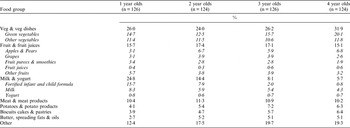Vitamin K1 has a key role in blood coagulation, bone metabolism and the regulation of calcification( 1 ). There are currently insufficient data available to set an average requirement for vitamin K1 for children however the European Food Safety Authority (EFSA) has recently proposed an Adequate Intake (AI) of 1·0 µg/kg bodyweight per day based on observed intakes( 1 ). Few data are available on vitamin K1 intakes in young children. The objective of this analysis was to estimate the intake and sources of vitamin K1 in Irish pre-school children aged 1–4 years (n = 500) using data from the Irish National Pre-School Nutrition Survey (2010–2011) (www.iuna.net). Dietary intake data were collected using a 4d weighed food record and the vitamin K1 content of foods was primarily determined using data from the UK food composition tables (COFID)( 2 ). For certain foods where vitamin K1 values were not available in COFID, the US( 3 ) and Danish food composition tables( 4 ) and published papers were used to assign suitable vitamin K1 values. The vitamin K1 content of composite dishes and retail products were calculated based on their ingredients. Usual intakes of vitamin K1 were calculated via the NCI-method( Reference Tooze, Kipnis and Buckman 5 ) using SAS Enterprise Guide. Body weight (kg) was measured in the participants’ homes by trained researchers. Differences in vitamin K1 intakes were assessed using a Kruskal-Wallis test (for non-normal data) and a Wilcoxon two sample test was used for post-hoc analysis. The mean daily intakes of vitamin K1 were 33, 30, 28 and 32 µg for 1, 2, 3 and 4 year olds, respectively. Adjusted for bodyweight, intakes (μg/kg/d) were 2·9, 2·1, 1·8 and 1·8 respectively showing a decrease (p < 0·001) with increasing age from age 1y to 3–4y respectively. Approximately 82 % of children had intakes above the AI of 1·0 µg/kg bodyweight per day. The table below reports the contribution (%) of food groups to vitamin K1 intake in Irish children aged 1–4 years, by age.

The main source of vitamin K1 for all ages was ‘vegetable and vegetable dishes’ (24–32 %, range across age), of which 13–20 % came from green vegetables. Other important sources were fruit & fruit juices (15–17 %), meat (10–11 %) and milk (6–25 %). The contribution from milk decreased significantly (p < 0·001) with increasing age from age 1y to age 3–4y primarily due to consumption of fortified infant and child formula in the earlier years( 6 ). Overall, these findings suggest that intakes of vitamin K1 are adequate for Irish pre-school children.
This research was funded by the Department of Agriculture, Food and the Marine under the project ‘Development of biofortification approaches for enhanced vitamin K content of foods (15/F/670)’


